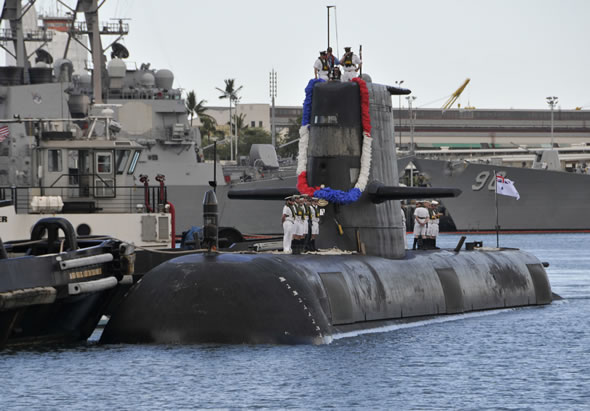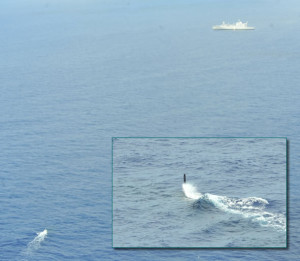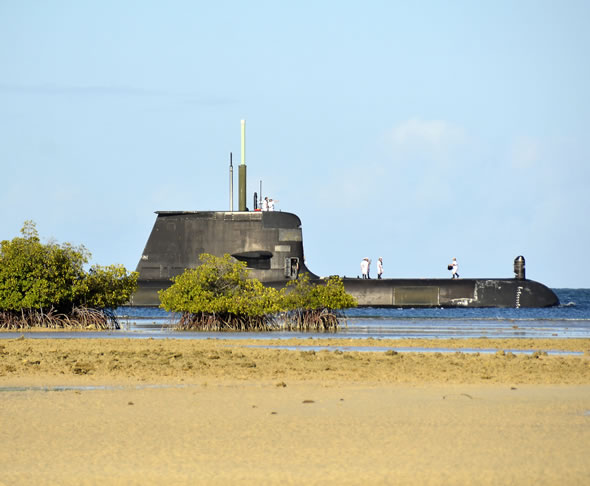
The HMAS Farncomb (SSG 74), an Australian Collins-class submarine, has put on quite a thrilling demonstration of her warfighting capabilities during the Rim of the Pacific 2012 (RIMPAC 2012) international maritime training exercise giving Australian national pride a welcome boost.
On 23 July HMAS Farncomb closed in on its prey, the 12,106 ton decommissioned USNS Kilauea (T-AE-26), and sank her in forty minutes with one MK48 torpedo. HMAS Farncomb’s single torpedo struck the USNS Kilauea just below the bridge breaking the vessel in two before she slipped beneath the waves some forty minutes after being hit. The decommissioned former ammunition ship sank in 15,500 feet of water 63 miles off the coast of Kauai Island in the Hawaiian Archipelago.
The sinking of the target ship was the highlight of a very successful Australian naval performance in RIMPAC 2012. Australia’s RIMPAC Combined Forces Maritime Component Commander, Commodore Stuart Mayer, stated that the Farncomb has performed exceptionally well against the US Los Angeles-class nuclear-powered “hunter-killer” submarines during this year’s RIMPAC exercise, a performance he says has come as quite a surprise to the assemblage of international naval officers participating in the exercise.
HMAS Farncomb is one of the largest conventionally-powered submarines in the world renowned for its undersea agility and quiet operation. In head-to-head competitions against American Los Angeles-class submarines, Commodore Mayer said the Farncomb frequently emerged victorious and said the vessel is “doing extremely well” in all aspects of the exercise. Commodore Mayer also said that foreign submariners were quite anxious to test themselves against the finely-tuned Farncomb crew. The Commodore further stated that the Farncomb had been developed into an exceptional warfighter that employed state-of-the-art combat systems and sophisticated weapon’s delivery systems incorporated into the vessel with American assistance.
Only two days after sinking the Kilauea, the Farncomb was herself the victim of a mishap while engaged in combat training. According to the Australian Defense Force (ADF), the Farncomb experienced flooding while cruising at periscope depth during an exercise. The flooding was identified as minor resulting from a shipboard water hose that unexpectedly split. At the time of the incident, the submarine was traveling just below the ocean surface under the power of her diesel engines while recharging her onboard batteries.
In a public statement, the ADF stated that the ship “suffered a minor flood in one of the submarine’s machinery spaces,” an event that triggered the immediate execution of standard procedures designed to guarantee the safety of the boat and the crew. In compliance with standard operating procedures, the ship’s captain ordered the vessel to surface as a precautionary measure.

The near sinking of the HMAS Dechaineux caused by the failure of a seawater cooling hose in 2003 led to the installation of an automated system in other undersea craft designed to close all hull valves should a similar mishap occur. The automated system was installed on the Farncomb and was readily available for use. Once the Farncomb surfaced, the crew was able to trace the flooding to a split hose in the boat’s weight compensation system. The damage to the hose was quickly contained to ensure the Farncomb remained seaworthy. The Farncomb was forced to retire from the ongoing exercises and sail for Hawaii to effect repairs to the damaged hose. An investigation will be conducted into the circumstanced of the incident.
This is not the first incident requiring the Farncomb to return to base for repairs. In 2010, the ship suffered a generator failure forcing her to return to port for immediate repairs. With Farncomb’s departure from her assigned area of operations, Australia was reduced to a force of only one mission-capable submarine as the fleet’s remaining four submarines were undergoing maintenance and repairs.
Australia is one of 22 nations participating in this year’s RIMPAC exercise. Australian soldiers are also training with US Marines in the conduct of amphibious operations and Royal Australian Air Force (RAAF) AP-3C Orions and a Wedgetail aircraft are also providing air support.

















